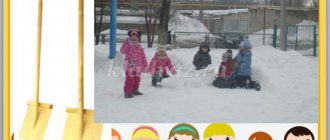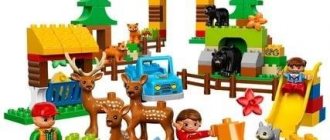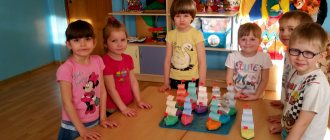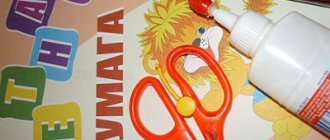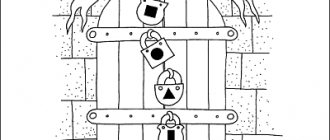GCD "construction for 1st junior group"House for a bunny"
GCD "Construction" in 1st junior group
"House for the Bunny"
Target:
Continue to develop the ability to construct elementary buildings according to the teacher’s demonstration and word, and use building materials to independently construct simple buildings in the game.
Tasks:
Cognitive:
1. Consolidate knowledge about the names of construction set parts: cube, brick, prism (roof).
2. Strengthen the ability to place parts on a plane, promote understanding of spatial relationships.
3. Activate children’s active and passive vocabulary using words: cube, brick, roof, house, bench, table, chair, sofa, guests, bunny.
Educational:
1.Develop memory, attention, observation.
2. Continue to teach children how to build elementary buildings according to a model, and show a desire to build something on their own.
3. Continue to strengthen the ability to use additional story toys, commensurate with the scale of buildings to play out the story.
4.Continue to teach children to put the construction set in a box after finishing the game.
Educational:
1.Promote care for animals; evoke positive emotions.
2. Continue to teach children to listen carefully to the teacher and follow verbal instructions.
Equipment:
1.Toy: hare.
2. For each child: a construction set (parts needed for construction: 10 cubes, 2 prisms, 5 bricks), 3-4 small toys to play out the plot.
GCD move:
1.Organization of children: The teacher organizes the children to form a circle and reads the nursery rhyme:
A steam locomotive goes and goes, two pipes and a hundred wheels,
Two pipes, a hundred wheels, a red dog as a driver.
Tra-ta-ta, tra-ta-ta, take your seats!
Children move like a train in a circle, then sit at the tables.
2. A surprise moment: a bunny comes to visit and tells him that the fox, whose house melted, kicked him out of the house and now he has nowhere to live.
3. The teacher invites the children to teach the bunny to build a house:
- clarifies with children what parts are on their table (cubes, bricks, roof);
-shows the technique of building a house from 8 cubes and a prism.
4. Children build a house based on the teacher’s model and verbal instructions.
5. Physical exercise.
Girls and boys jump like bunnies.
Hands clap, feet stomp,
They nod their heads, crouch low,
And then everyone gets up, waves their hands: “Salute”!
6. The teacher says that guests may come to the bunny and offers to build a bench, table, and chairs for them near the house. Reminds us of what parts they can be built from (a bench from bricks, a table from a cube and a brick, a chair seat from a cube, a back from a brick). Children build buildings.
Abstract of OOD on design in the first junior group topic “Let's build a bus”
Author: Marina Valerievna Vasilenko, teacher of the Municipal Preschool Educational Institution “Kindergarten No. 16 of a general developmental type”, Ukhta
Description of the material: I offer a summary of organized educational activities for children of the first junior group (2-3 years old).
Abstract of OOD on design in the first junior group
theme "Let's build a bus"
Objectives: to train children in elementary methods of construction: placing parts and placing them on top of each other. Teach to distinguish details and name them. To develop children’s desire to design and promote speech activity. Teach how to disassemble buildings and put parts in the middle of the table.
Material: a set of cubes, bricks and plates for each child. Large toys: bus and car. Small toys: cars, animals, nesting dolls, etc.
Educator:
Guys, I suggest you go on a trip today, take chairs and build a “bus” (children take chairs and sit on the “Bus”).
Here we are on the bus, sitting and sitting and sitting (slapping our knees)
From the window we look, we look, we look everything
We look back, we look forward (turn their heads left and right)
That's it, that's it, that's it, well, the bus doesn't carry you
The wheels are spinning (circular movements of the shoulders)
Just like that, just like that, we rolled forward (imitation steering wheel)
Like this, like this, and the brushes rustle on the glass
Whip, whack, whack (movements with palms, waving)
We're going, we're going (imitation steering wheel)
Everything forward, everything forward, everything forward, where is the bus taking us, taking us, taking us.
Educator
:- Look, the toys and dolls are sitting very sad, they probably also want to go on an excursion or some kind of trip. Let's guys build a bus for them.
The teacher shows and analyzes a sample of a bus built in advance.
Educator
:- The bus is long - many passengers can travel on it. The bus has many windows and seats. The bus also has wheels.
Educator
:- Guys, is there a new one among the parts you are familiar with? (The children discover that the wheels are built from new parts)
Educator
:- This part is called a cylinder. You can put it on, you can roll it around. What does a cylinder look like? (Children's answers: on a post, on a log, on a mug)
Then the teacher tells how to build a bus, one of the children follows his instructions.
Educator
:- You need to put two cylinders so that they roll, and a plate on them. Place four cubes on the plate at equal distances from each other, and place the same long plate on top.
After the explanation, the children begin to build. To prevent the cylinders from rolling out, you can offer children napkins made of soft fabrics. When the buses are ready, the children take small toys and place them in the passenger seats. The teacher, on behalf of the toys, thanks the children and asks where they will go on an excursion.
MAGAZINE Preschooler.RF
Project in the first junior group “Magic cubes”Completed by: teacher Kornilova T.V. Municipal government educational institution kindergarten No. 9 “Solnyshko”, Chkalovsk 2020
Explanatory note:
Constructive activity is a practical activity aimed at obtaining a specific, pre-thought-out real product that corresponds to its functional purpose. design has extremely wide possibilities for mental, moral, aesthetic, and labor education.
Construction of various buildings from building materials for young children. During the construction process, children's sensory and thinking abilities are developed. Playing with building materials has an impact on the all-round development of the child. Children's construction is closely related to play: children's buildings are used for practical use and for play. In children aged 2–3 years, construction and play “nearby” .
A variety of building materials develops children's creative activity. Therefore, it is necessary to create the necessary conditions and select materials for the developing subject environment. You should consider placing a variety of building materials in the group room, placing it accessible so that it is convenient for children to play with it.
LEGO sets Builder set (cube, brick , cone, cylinder) are used. To play with buildings, you need toys that are commensurate with the buildings being created (cars, dogs, cats, nesting dolls, etc.).
Relevance:
The problem of developing interest in design in preschool children occupies a significant place in preschool pedagogy. Since a variety of constructive creativity gives children the opportunity not only to explore the world around them, but also to comprehensively develop their abilities.
The relevance of the problem of conducting design classes in preschool institutions is that at this stage of development of society, fewer hours are devoted to design for children to master than other disciplines (speech development, cognition, drawing, etc.)
Construction in the learning process is a means of deepening and expanding the acquired theoretical knowledge and developing the creative abilities, inventive interests and inclinations of students.
The purpose of the project: to develop the ability to carry out this or that construction, to know the names of buildings; develop the child’s thinking, intelligence and creativity, his moral qualities, aesthetic feelings.
Project objectives:
- Development of cognitive interest of preschool children in design.
- Formation of design skills and abilities, gaining first experience in solving design problems, getting to know designers.
- Development of creative activity, independence in making optimal decisions in various situations, development of attention, working memory, imagination, thinking.
- Development of fine motor skills and hand coordination in preschool children.
- Developing responsibility, discipline, and communication skills.
- Promote the formation of active speech.
The main form of training: directly organized educational activities.
Working methods and techniques:
- observation;
- sample display and analysis;
- explanation of the sequence and methods of construction;
- clarifications, questions;
- artistic word;
- gaming techniques;
- playing around with created buildings;
- analysis and evaluation of the work process.
Forms of organization:
- lesson in subgroups;
- individual work with a child;
- teamwork;
Project participants: children of the first junior group, teachers, parents.
Type of project: group.
Duration: 1 year
Expected results:
- The child shows initiative and independence in various types of activities - play, communication, construction; able to select participants for joint activities.
- The child has developed gross and fine motor skills; can control and control his movements.
- The child has developed a strong interest in design activities and a desire to experiment.
- The child masters the techniques of individual and joint design.
Plan
Stage 1 – preparatory.
Tasks:
- Study and selection of methodological literature on the topic of the project.
- Think over a system of activities with children of the first junior group to achieve the goals and objectives of the project.
- LEGO sets Builder sets (cube, brick , cone, cylinder, toys commensurate with the buildings being created (cars, dogs, cats, nesting dolls, etc.)
- stage – practical.
Tasks:
- Learn to name the parts of the LEGO construction set, continue to learn to name the parts of the “Builder” (brick, cube, cone, prism).
- Teach the simplest analysis of constructed buildings (identify the shape, size, color of details).
- Carry out the simplest design in accordance with the given conditions (bed for a doll).
- Compare objects by length and width.
- Enrich speech with phrases (the red track is long (wide).
- Design according to the sample and conditions.
- Distinguish by color and shape.
- Develop hand-eye coordination when connecting construction parts, achieve precision in the process of operational actions.
- stage – final.
Tasks:
- Observe whether the knowledge acquired by children during the project is reflected in independent activities.
- Summarize.
Literature:
- Arapova - Piskareva N. A. Formation of elementary mathematical concepts in kindergarten: program and method. recommendations. For classes with children 2 – 7 years old. – M.: Mosaika-Sintez, 2008.
- Gubanova N. F. Development of gaming activities. System of work in the first junior group of kindergarten. – M.: Mosaika-Sintez, 2008.
- Kutsakova L. V. Design and manual labor in kindergarten: program and method. recommendations. For classes with children 2 – 7 years old. – M.: Mozaika-Sintez, 2010.
- Lishtvan Z.V. Design. – M.: Education, 1991.
- Petrova V. A. Classes on speech development with children under three years old. – M.: Education, 1970.
- Chernova E.I., Timofeeva E.Yu. Finger steps: exercises for the development of fine motor skills. – St. Petersburg: Corona-century 2007.
Conclusions on the implementation of the project on design and modeling with children of early preschool age in the first junior group “Teremok”
Children transfer the knowledge and skills acquired in classes to independent activities.
In the first junior group, children play with parts that are familiar to them. It is very important that an adult takes direct part in children's games. To do this, I used such techniques as: reminding them of what we built earlier, how we played with buildings and toys, and inviting the children to repeat or change the building I made.
In the game, children improve, rebuild, and add various details to the same building over many days. When acting out the building, I suggested possible actions to the children or showed them how to do it. She made sure that the children handled the building material carefully and, at the end of the games, put it away in a permanent place.
It is necessary to notice successful buildings that a child has created by chance, to attract the attention of other children to them, and to praise the child for his independence and activity.
When children play with building materials, it is necessary to maintain good relationships between the kids: teach them not to disturb each other, share toys, and respond to a peer’s request.
As a result of the project, the child can:
know
- basic building parts (cubes, bricks , bridges, etc.);
- basic design techniques;
- primary colors.
be able to
- change buildings in two ways: by replacing some parts with others or building them up in height and length;
- connect LEGO pieces,
- play around with buildings.
have an idea
- about the simplest analysis of created buildings;
- about options for creating structures when adding other parts.
| Next > |
Practical aspects
Papermaking classes are organized in accordance with the federal state educational standard for preschool education (FSES), Federal Law No. 273 of December 29, 2012 “On Education in the Russian Federation” and SanPiN 2.4.1.3049-13. Teachers draw up a work plan and technological maps for each lesson.
Technological maps and diagrams
The technological map should reflect the following points:
- topic of the lesson;
- the purpose of the activity and its objectives;
- preliminary work;
- didactic materials and equipment;
- description of the stages of the lesson (organizational moment, main and final parts) indicating their duration, words of the teacher, expected answers and actions of the children.
Lesson duration
The preparatory group conducts design classes lasting 15-25 minutes.
They include the following steps:
- organizational moment - 1-3 minutes;
- demonstration and explanation of working methods - 3-5 minutes;
- independent activity of pupils - 5-10 minutes;
- discussion of crafts - 2 minutes;
- final part - 1 minute.
Introductory materials
To familiarize children with the topic of the lesson and create motivation, game techniques are used.
Their choice depends on the imagination of the teacher:
- riddles (to introduce the hero);
- game “Hide and Seek” (children find a toy using sentences, for example “The doll is behind the closet”);
- exercise “Guess” (the teacher shows 4 pictures and asks to recognize the guest by naming his signs);
- game technique “Letter” (the wizard sends a letter in which he asks the children to help him do something);
- “The fourth odd one” (out of 4 toys, students must choose the one that is different from the rest - it will be the heroine of the lesson).
Summary of lessons on designing Teremok nursery
Abstract of GCD for the design of “Teremok”
Target
: developing children’s ability to create simple buildings in joint activities.
Tasks
educational activities:
continue to teach children to create a building from ready-made geometric shapes (bricks, cubes, roofs), analyze the object, see the main parts and details that make up the structure;
teach how to build a house according to conditions and models;
exercise the ability to distinguish and name geometric shapes: cube, roof, brick;
expand and enrich children’s vocabulary, strengthen dialogic speech skills;
develop design skills, spatial thinking;
cultivate independence;
develop coordination of hand movements, attention, thinking;
learn to differentiate the concepts of “big and small”;
cultivate a love for animals, develop cognitive interest;
create a joyful mood, an emotional mood.
Integration of educational areas:
“Cognition”, “Communication”, “Socialization”, “Work”, “Music”, “Reading fiction”.
Preliminary work:
reading Teremok fiction, looking at illustrations, constructing outside classes in subgroups and individually, looking at photographs of houses of different sizes, designs and purposes, consultations for parents.
Equipment:
wooden floor construction set, Lego construction set, plastic construction set, soft modules, diagrams, counting sticks.
Activating the dictionary:
brick, cube, door, walls, roof, window.
Progress of educational activities:
Surprise moment:
There is a knock on the door, a bear from the Russian folk tale “Teremok” comes in and cries.
Pedagogical technologies used:
• gaming
• information and communication
• personality-oriented
• health-saving
Artistic and aesthetic development:
• strengthen children’s ability to construct buildings according to a model and support the desire to build something on their own
• consolidate children’s knowledge of the names of construction kit parts
Speech development:
• develop dialogical speech
• cultivate interest in communicating with adults and peers
• activate nouns in the children’s dictionary (teremok, builder, little mouse, frog-frog, runaway bunny, top-gray barrel, little fox-sister, clumsy bear, verbs (lounged, galloped, roared, squeaked)
Cognitive development:
• maintain children's interest and active actions with objects and geometric bodies
• develop attention, thinking, sensory perception
Social and communicative development:
• cultivate friendly relationships during joint activities
Theoretical aspects of training
Paper construction (paper-plastic) is a type of activity for preschoolers that involves:
- drawing up an action plan;
- selection of materials for crafts;
- performing manipulations using the chosen technique.
In kindergarten, children construct crafts in classes organized by the teacher in a playful way.
Lesson objectives
Before planning a lesson, the teacher must set a goal that he wants to achieve. It is implemented through several tasks.
Educational objectives:
- introduce the properties of different types of paper (classic, velvet, holographic, crepe);
- develop the ability to cut out the necessary parts for a craft and name them (square, circle, etc.);
- clarify ideas about colors and their names;
- learn to make three-dimensional shapes from paper blanks by bending, crumpling, twisting or tearing them;
- encourage the creation of products according to plan (independently choose the theme and material for the craft);
- learn to combine elements into a composition (for example, roads and houses are a street).
Correction and development tasks:
- develop fine motor skills, thinking, attention and memory;
- improve visual and tactile perception;
- develop the ability to analyze created crafts and, based on this, plan your further actions;
- develop imagination.
Educational tasks:
- develop the ability to maintain order in the workplace and put tools in their place after finishing work;
- cultivate kindness, love of nature, etc. (depending on the craft).
Types of paper designs
Paper plastic is divided into 2 types:
- origami - folding figures by bending paper;
- volumetric paper and cardboard modeling, involving the use of scissors and glue.
Design forms
There are 7 forms of organizing constructive activities:
- Pattern design developed by F. Fröble. The teacher’s actions serve as an example. Children repeat what is shown, learning new techniques for working with various materials.
- Model design proposed by A. N. Mirenov. Instead of a sample, a model is used in classes - a ready-made craft. The method for creating the product is not shown. Students must recreate the model themselves. This form of organizing activities is used when working with children 5-6 years old and older. It helps to activate the thinking of preschoolers, because... they need to mentally disassemble the product into its components and reproduce the procedure unknown to them.
- Design according to conditions, developed by N. N. Poddyakov. He suggested not giving children ready-made samples and ways to solve a problem. The underlying conditions must be problematic in nature. For example, students are asked to make an object out of paper that can be given to their mother on March 8th. This method allows you to develop thinking and imagination. It is used if children have already made given objects or analyzed products that are similar in structure.
- Design based on drawings and visual diagrams. The authors of the method are S. Leon Lorenzo and V. V. Kholmovskaya. When working with preschoolers, templates are used. Children learn to use drawings as a way of understanding an object and how to create it.
- Design by design. For kindergarten students, this activity is difficult. In order for them to think creatively, the teacher must form in children an idea of the objects being created, the ability to repeat the teacher’s actions and look for new ways to create crafts. Only after preschoolers have mastered the existing methods of paper modeling will they be able to creatively use the knowledge they have acquired.
- Design on the topic. This form is close to making crafts by design. The difference is that the teacher limits the idea to the topic. For example, a teacher invites children to create any craft on the theme “Autumn.”
- Frame design proposed by N. N. Poddyakov. This method is rarely used when working with preschoolers. The teacher shows a frame made of any material, and then does something that changes the structure. With such training, children learn not only the structure of the frame, but also how to change it.
Motivation for children
To make it interesting for preschoolers, you can turn the activity into a game: bring a toy (hero) and invite the children to make a house or a gift for him.
It is important that children understand the practical significance of their activities. They will be more motivated if they know that their product can be given to an adult (mom, dad, grandmother, etc.).

